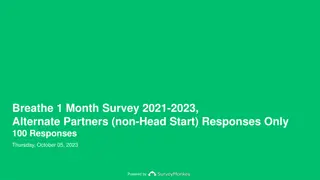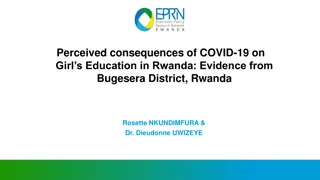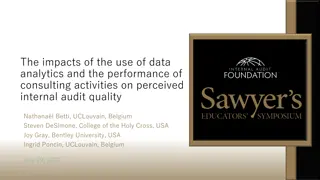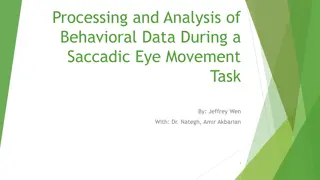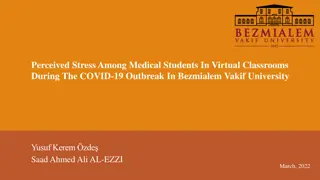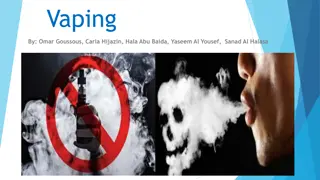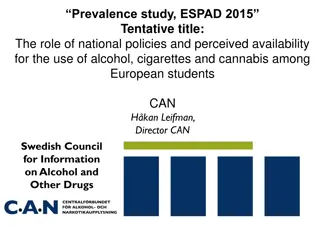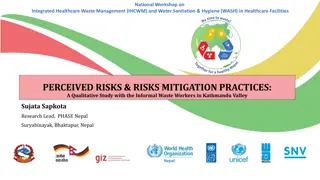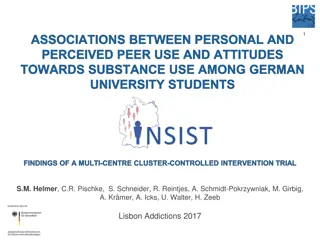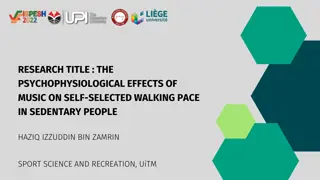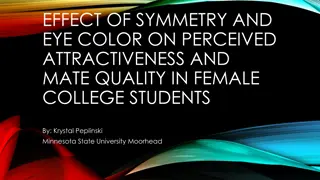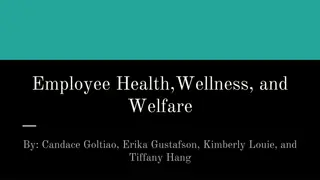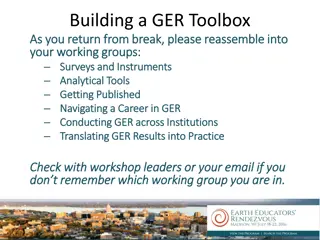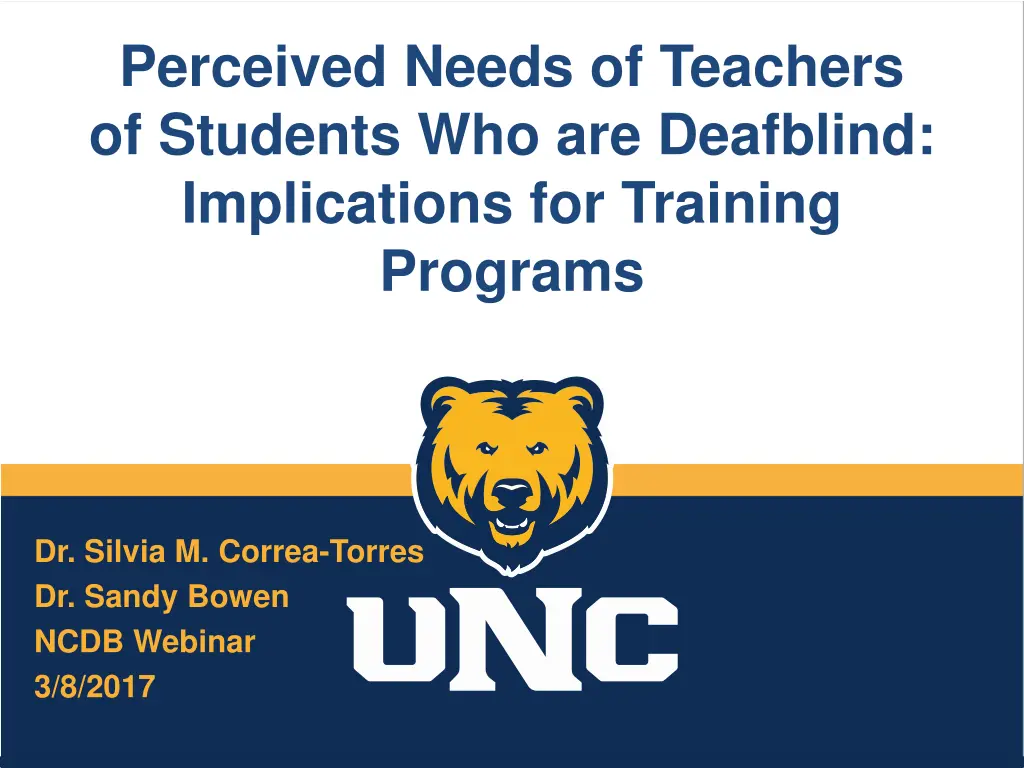
Teachers of Deafblind Students: Perceived Needs & Training Implications
Explore the perceived needs of teachers working with deafblind students and the implications for training programs. Data analysis, participant insights, and university programs are discussed in this informative webinar summary.
Download Presentation

Please find below an Image/Link to download the presentation.
The content on the website is provided AS IS for your information and personal use only. It may not be sold, licensed, or shared on other websites without obtaining consent from the author. If you encounter any issues during the download, it is possible that the publisher has removed the file from their server.
You are allowed to download the files provided on this website for personal or commercial use, subject to the condition that they are used lawfully. All files are the property of their respective owners.
The content on the website is provided AS IS for your information and personal use only. It may not be sold, licensed, or shared on other websites without obtaining consent from the author.
E N D
Presentation Transcript
Perceived Needs of Teachers of Students Who are Deafblind: Implications for Training Programs Dr. Silvia M. Correa-Torres Dr. Sandy Bowen NCDB Webinar 3/8/2017
Overview Often professionals working with students who are deafblind face challenges for which they may not be prepared. Results of a survey of educators perceived needs of students who are deafblind will be presented. Implications for teacher training programs will be provided.
University Programs At the time of our survey, we identified 10 programs; Linda McDowell and Elizabeth Bell are creating a document that outlines all of the University Preparation Programs that offer content in deafblindness; If you have not already, please contact them with your information.
Participants Participants Teachers of the blind/visually impaired, Teachers of the deaf/hard of hearing, and Special education teachers who work with students who are deafblind. Recruitment Announcement posted in major professional organizations in the fields of visual impairments and deafness, state listeners.
Participants (cont.) Number Total of respondents N=254 Final number N=198 Missing data 28 States represented
The Survey Demographic information; Questions that identify educational practices and educational needs when teaching students who are deafblind; Open-ended questions.
Data Analysis Procedures (Quantitative) Quantitative Data Analysis Descriptive statistics, means, standard deviations, and percentages were calculated using SPSS software. Demographic data is represented through frequencies and percentages to give a detailed description of the sample.
Data Analysis Procedures (Qualitative) Qualitative Data Analysis (open-ended questions) Data were analyzed to determine systematic categories through coding; Independently coded by two researchers and compared for consistency through all phases of the data analysis process; Constant comparison method.
Gender Responses % 16 8.1% Male 182 91.9% Female 198 100% Total
Ethnicity Response % White-Non- Hispanic Black American Hispanic American Native American Indian Asian American Other (please indicate): Total 183 92.4% 4 2% 3 1.5% 0 0% 5 2.5% 3 1.5% 198 100%
Vision and Hearing Status 2.5% of respondents identified as blind or visually impaired 6.5% of respondents identified as deaf or hard of hearing
Years of Experience 0 5 Years 6-10 Years 11 15 Years 16 20 Years 21 25 Years 26 30 Years 31 35 Years 35+ Years 11 39 32 22 34 18 17 12 *Range: 0 42 years *Average: 18.3 years
Education 80 70 60 50 40 30 20 10 0 B.A. or B.S. M.A, M.S, M.Ed. Specialized Degree Ph.D. or Ed.D. Other
Teaching Environment Rural, 28.20% Urban, 33.80% Suburban, 46.50%
Role TVI (85/42.9%) TOD (44/22.2%) Both (14/7.1%) SpEd (10/5.1%) DB Spec. (5/2.5%) Other (39/19.7%)
Primary Teaching License Response % Blindness/Visually Impaired 81 40.9% Deaf/Hard of Hearing 46 23.2% Special Education 52 26.3% Other 19 9.6%
Job Responsibility Response % Itinerant 123 62.2% Case Manager 64 32.3%
Program Types Other Special School or Center Regional Program District Programs 0 20 40 60
University Preparation Response % Yes 72 36.4% No 126 63.3% Total 198 100%
Professional Development % Response Yes 125 63.1% No 73 36.9% Total 198 100%
Ranking Questions 1. Accessibility to resources in the area of DB 2. Assessment issues related to students who are DB 3. Creating supportive environments for students who are DB 4. Curriculum modifications that will promote learning for students who are DB 5. Etiology of DB
Ranking Questions (cont.1) 6. Familiarity with communication methods used by students in your caseload 7. Knowledge to enhance communication for students who are DB 8. Strategies to enhance communication for students who are DB 9. Strategies to work collaboratively with families of students who are DB 10.Strategies to work collaboratively with IEP team of students who are DB
Ranking Questions (cont.2) 11.Teaching techniques effective with students who are DB 12.Understanding of impact of teacher expectations of students on your caseload 13.Understanding of impact of parent/family expectations of students on your caseload 14.Understanding the unique needs of students who are DB 15.Use of assistive technology to meet the need of students who are deafblind
Program Priorities 1. Understanding the unique needs of students (103/52%) 2. Teaching techniques (65/32.8%) 3. Accessibility to resources in the area of DB (62/31.3%) 4. Assessment issues (57/21%) 5. Creating supportive environments (51/25.8%)
Non-Priorities 1. Understanding of impact of parent/family expectations of students (128/64.6%) 2. Understanding of impact of teacher expectations of students (121/61%) 3. Etiology of DB (83/41.9%) 4. Strategies to work collaboratively with IEP team (46/23.2%) 5. Use of assistive technology to meet the needs of students (45/22.7%)
Open-Ended Questions 1. What are the three (3) most pressing needs you have in teaching students who are deafblind? 2. Describe collaborative strategies you use to meet the needs of students who are deafblind in your caseload. 3. What suggestions do you have for teacher preparation programs to better prepare educators who work with students who are deafblind?
Themes Training Communication issues Importance of collaboration Best practices when teaching students who are deafblind Knowledge of available resources
Training Not sure what my role is or what I am expected to do ; This disability was not even touched upon [in my program] ; I do not feel I was given any instruction in this area Give multiple opportunities to learn practical strategies in addition to theory ; For DHH teachers it would be beneficial to have a few units dedicated to servicing this unique population ; More dual certification programs ; Hands-on experiences! .
Communication Issues Not having an interpreter when working with my students ; Being able to communicate with students ; Implementation of an effective communication system ; Understanding their communication methods ; Having everyone working with the child use the same techniques for communication .
Importance of Collaboration Issues: Lack of collaboration ; Finding time to collaborate ; Long range collaborative planning between service/education agencies ; Strategies: Regular communication with team members ; Weekly meetings ; In-service trainings ; Journals, emails, phone calls, text messages .
Best Practices What are best practices for teaching students who are deafblind? ; Understanding different teaching approaches ; How to effectively assess students who are deafblind? ; How to modify the curriculum? ; Age appropriate curriculum/strategies .
Knowledge of Available Resources Accessibility to materials ; What technology to use? and Access to technology ; Easy to understand resources for administrators ; Not knowing where to find resources ; Funding for appropriate materials and Finding appropriate materials .
Discussion Conflict between the ranking and the themes from open-ended questions: Pre-service vs. In-service training; Resources, knowing what is out there; Communication & collaboration. Additional needs: Working with families; The use of interveners.
Next Steps Include instruction in the other sensory discipline in personnel preparation programs; Greater focus on the implications of dual vision/hearing loss; Appropriate assistive technology. Information on state-wide agencies and specialty resources for students with deafblindness; Wider range of assessments.
Next Steps (cont.) Minor or specific courses in deafblindness; Better explanation of the various roles of teachers, professionals, and families in the lives of their students with deafblindness; More classroom experience with actual students who are deafblind.
silvia.correa-torres@unco.edu sandy.bowen@unco.edu THANK YOU!


